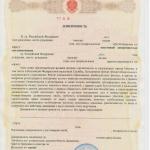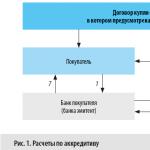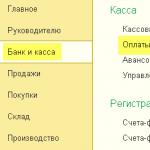Debit balance on account 57. Postings if necessary, specifying the buyer
Account 57 “Transfers in transit” is intended to summarize information on the movement of funds (transfers) in the currency of the Russian Federation and foreign currencies in transit, i.e. sums of money (mainly proceeds from the sale of goods of organizations engaged in trading activities) deposited in the cash desks of credit institutions, savings banks or post office cash desks for crediting to the current or other account of the organization, but not yet credited for their intended purpose.
The basis for accounting for amounts in account 57 “Transfers in transit” (for example, when delivering proceeds from a sale) are receipts from a credit institution, savings bank, post office, copies of accompanying statements for the delivery of proceeds to collectors, etc.
The movement of funds (transfers) in foreign currencies is accounted for separately on account 57 “Transfers in transit”.
Account 57 "Transfers on the way"
corresponds with accounts
| by debit | on loan |
|
50 Cashier 51 Current accounts 52 Currency accounts 76 Settlements with various debtors and creditors 79 On-farm 90 Sales 91 Other income and expenses |
50 Cashier 51 Current accounts 52 Currency accounts 62 Settlements with buyers and customers 73 Settlements with personnel for other transactions settlements |
Application of the chart of accounts: account 57
- Online cash registers for housing and communal services
Bank accounts, as well as making transfers of funds without opening bank accounts, including... funds in favor of the recipient without opening a bank account when transferring electronic funds... payment for goods, works, services by transferring funds within the applicable forms of non-cash ... companies should be recorded using account 57 “Transfers in transit” as is usually done...
- Accounting policy of LLC in 1C: Accounting 8, ed. 3.0
... – “Setting up a chart of accounts” – “Retail goods accounting”. Main cost accounting account In this item... another account, in the menu “Main” – “Settings” – “Chart of Accounts” you can view all the accounts... of the repair shop at the plant. Account 57 “Transfers in transit” is used. We check the box if we want ... movements of funds are reflected in account 57. It makes sense if you have... withdrawing/depositing cash from a bank account. Reserves are formed for... for 20 and 90 accounts, otherwise you have...
- Accounting in a grocery store
And operations with it within the framework of synthetic accounts. In practice, the interaction of such... should be carried out on account 90 “Sales”. In the “Credit” column of this account there should be... automatic entries reflect this in the following form: Debit account 90 “Sales”, subaccount... accounting looks like this: Debit account 57 “Transfers in transit” Credit account 90 “Sales” , sub-account “Revenue... and reduction of trading costs due to errors in accounting for marketable products sold.
- Moment of recognition of revenue when paying with cards (STS)
Payment cards. The organization applies in this case account 57. At what point is the amount paid... payment cards. In this case, the organization applies account 57. At what point is the amount paid... in funds to his current account in an amount equal to the cost of goods sold... receipt of funds in bank accounts and (or) at the cash desk, receipt of other things. .., hereinafter referred to as the Chart of Accounts), account 57 “Transfers in transit” is provided. Based on the Chart of Accounts, in accounting...
- Accounting and taxation of game currency
Based on the use of account 55 “Special accounts in banks” or account 57 “Transfers in transit” ... organization” in the accounting policy of the organization, it is necessary to approve an account for accounting movements... ; - expenses for electronic money transfer are taken into account. USN In accordance with the p... of funds, in particular, to bank accounts (cash method). In case of payment... .15 of the Tax Code of the Russian Federation in case of receipt of proceeds from...
- Income tax in 2018: clarifications from the Russian Ministry of Finance
The lender by offsetting the amounts of claims under the debt obligation against the contribution to the authorized capital... Regarding the notarization of the translation of a certificate confirming permanent residence in a foreign country, with... establish requirements for the notarization of the translation of the above document. Letter dated 9... - the lender by offsetting the amounts of claims under the debt obligation against the contribution to the authorized capital... -06/1/35857 Requirement of subclause 57 of clause 1 of Article 251 of the Tax Code...
- Digest of legal information for specialists in the field of labor law for the fourth quarter of 2018
Periods are converted into full months, and every 12 months of these periods are converted into full months... I recalled that from the contents of Art. 57, 135 of the Labor Code of the Russian Federation it follows that... the Russian Federation to the extent that the provision contained therein - due to the absence of... by increasing the amount of severance pay for a dismissed employee by including a corresponding condition in... an employment contract or collective agreement ; 2. by using... motivating this by the fact that after transfer to a new position, an agreement on...
- About some evidence in tax disputes
He chooses mysterious paths for himself - this means that there is a crookedness in the paths of justice... July 30, 2013 No. 57 “On some issues that arise when... 188), Code of Criminal Procedure of the Russian Federation (Articles 57, 58), and, as we have already... July 30, 2013 No. 57 “On some issues that arise when... the party and ultimately the people themselves. This system is absolutely... Recognition of the semantic translation of the Koran as extremist material and issues of due legal... . Recognition of the semantic translation of the Koran as extremist material and issues of due legal...
- The employer will be informed about the debt of employees in payments to the budget
Established taxes according to Art. 57 of the Constitution of the Russian Federation, including tax on...) of an individual of interest by sending a corresponding request to the FMS. If the requirement... contained in the executive document; within three days from the date of these payments, transfer the withheld... funds to the creditor to the bank account whose details are indicated in...). Please note: Transfer and transfer of funds are made at the expense of the debtor (part...
- Accounting for expenses under the simplified tax system. Features of recognition in the tax base
“Simplers” are also obliged to follow. It now directly states... significantly expands the possibilities of “simplified workers” in terms of recognizing expenses in the tax base... an employee who is constantly or regularly on the road is entitled to compensation for the traveling nature of... labor. In accordance with the Labor Code, the employer is obliged at the expense of his own... 2009 No. 03-11-06/2/57). For the same reason, it is impossible... reconstruction, design work, transfer of an apartment from residential to non-residential. Letter from the Ministry of Finance...
- Artificial “fragmentation” of business as an unacceptable way to minimize taxation
Their reorganization (Articles 57, 58 of the Civil Code of the Russian Federation). Actually... 2017). 9. Simultaneous mass transfer of employees and transfer of logistics... A66-17494/2015). 25. “Transfer” of contracts with key counterparties from... a participant in a “fragmented” business by actually transferring them to another, again... payment by taxpayers to the budget system of the Russian Federation, by calculation based on... dated 07.30.2013 No. 57 “On some issues arising... dated July 30, 2013 No. 57 “On some issues arising...
- Issues related to concluding a student agreement
... (paragraph 3, part 2, article 57, article 195.1 of the Labor Code of the Russian Federation... of the parties. Thus, the student agreement can include a condition on the transfer of an employee for... less than the period established by the contract (Article 57 of the Labor Code of the Russian Federation) A similar condition may... him for training at the expense of the employer, in case of dismissal without valid reasons...: lack of work, the need to transfer to another job in accordance with a medical report... funds voluntarily (by depositing in the organization's cash desk or transfers to the current account) By...
- Review of letters from the Ministry of Finance of the Russian Federation for March 2018
Replenishment of special-purpose funds to increase income or otherwise related... expired products through processing or destruction. Taking into account... the collector in payment of the debt, will be equal to the amount of debt, in payment of which... the norms of paragraphs 56 and 57 of Article 217 of the Tax Code of the Russian Federation when... The remuneration paid to the translator for carrying out translation in the course of criminal proceedings is subject to.. . translation services during criminal proceedings, set out in a letter from...
- Vacation pay in 2017: what to pay attention to?
Explanations on this matter are given in letters from the Russian Ministry of Labor dated... are not included in the number of calendar days of vacation. The duration of vacation is increased due to... by (Part 1 of Article 57 of the Civil Code of the Russian Federation): mergers; accessions; divisions; discharge; transformations. In... -legal predecessors. The employee went on leave in May 2017. ...an employee is hired by way of transfer from another company... An employee is hired by the company by way of transfer from May 2, 2017. On May 15 he went to...
- Review of letters from the Ministry of Finance of the Russian Federation for August 2018
01-11/54583 In accordance with Article 57 of the Constitution of the Russian Federation and... Regarding the notarization of the translation of a certificate confirming permanent location in a foreign state, with... establish requirements for notarization of the translation of the above document. A letter of 10... operations to write off funds to pay taxes, penalties and fines... is calculated. If the borrower fulfills his obligations under the loan agreement by transferring to the lender...
Learning to enter acquiring transactions (1C: Accounting 8.3, edition 3.0)
2017-06-13T22:31:11+00:00Today we will learn how to make payments from customers through payment cards (Visa, MasterCard and others).
In another way, such operations are also called acquiring:

In the journal that opens, click the “Create” button:

Our type of operation is naturally “Retail revenue”:

Fill in the date and the warehouse field (with the type manual point of sale):

Create a new payment type:

- Payment type: Payment card
- Name: for example, Visa
- Counterparty: our acquiring bank VTB
- Agreement: Acquiring Agreement (you can also specify the number and date)
Don’t forget to also indicate the percentage of the bank’s commission for acquiring services (1%).
It will turn out like this:

We will indicate the payment amount and post the document:

Let's look at the wiring (DtKt button):

That's right:
62.R(retail buyer) 90.01.1 (revenue) 100,000 (revenue reflected)
57.03 (translations on the way) 62.R(retail buyer) 100,000 (revenue in transit, expected transfer from the acquiring bank to our current account)
According to the statement dated January 2, the money (except for the commission) was transferred to our bank account.
To reflect the receipt of money, let’s go to the just created document “Payment by payment cards” and create on its basis “Receipt to the current account”:

Please note that the program automatically allocated the bank commission (in this case, 1,000 rubles):

And she attributed it to other expenses (account 91.02):

Let’s go through the document and look at the postings (DtKt button):

That's right:
51 (our current account) 57.03 (transfers in transit) 99,000 (payment minus commission credited to our account)
91.02 (other expenses) 57.03 (transfers in transit) 1,000 (acquiring fee costs)
By the way, if the revenue was not retail (62.R), but a regular payment from the buyer (a specific counterparty) - we simply should have selected “Payment from the buyer” as the type of transaction and then everywhere instead of 62.R 62.01 would appear indicating the selected by us the buyer (counterparty).
That's all
By the way, for new lessons...
Sincerely, Vladimir Milkin(teacher
Account 57 “Transfers in transit” is active, serving to obtain generalized information about the movement of funds sent for crediting to the company’s accounts, but not yet received at the moment. The amounts listed on it are subject to frequent and thorough audits by auditors.
The audit process and why it is needed
Inspections pursue understandable goals - control of reporting for the economically stable existence of the organization. The legality and reliability of the information provided by the accountant are the basis for the correct accounting of the company’s money. The audited company must comply with the following rules:
- provide reliable information on account balance 57;
- timely transfer income from the organization’s activities;
- correctly reflect the accounting of foreign exchange transactions.
The audit is based on a thorough study of all primary accounting registers that lead to the appearance of entries in the “Transfers in transit” account.
Accounting characteristics
57 accounting account is a way of modern description of the process of transferring funds to bank accounts. Almost every trading organization transfers amounts from the cash register and proceeds for the reporting period to the account. The use of account 57 begins with such operations, which allows for more reliable and continuous accounting.
In addition to the funds transferred by the organization, transfers in transit include amounts sent from buyers on account of goods or services received, but which did not manage to be credited to the current account before the end of the reporting period. Funds allocated for currency conversion are also debited in account 57.
Account application
Account 57, according to the order of the Minister of Finance of the Russian Federation, serves as a source of information about the movement of money in ruble and foreign currency equivalent. It is used in cases where the transfer of funds to a bank account is delayed for a period of 1 day or more from the moment of sending. In addition to the bank, the organization uses the services of savings banks and post offices for settlement transactions.
It is necessary to have a basis in the form of primary accounting documents. These are receipts from executive agencies, as well as accompanying statements for the delivery of proceeds to collectors and other accounting registers. The movement of foreign currency funds must be organized separately from other transfer operations.
Correspondence with other accounts
Account 57 is active, which means that any inflow of funds is recorded in debit, and write-off is recorded in credit. At the end of the reporting period, a debit balance is formed, or the account is closed if the funds in transit have managed to transfer to the main bank accounts. Based on the characteristics of the account, it is possible to distinguish between its correspondence in debit and credit with other accounts.

Account “Transfers in transit” is debited to the accounts:
- monetary (accounts 50, 51 and 52, “Intra-economic settlements”);
- settlements with buyers and creditors (accounts 62, 64, 76);
- settlements with dependent organizations (account 78);
- sales of products (accounts 45 and 46);
- profit and loss (account 99).
Closing account 57 - loan correspondence - is most often performed from the account. 50, 51, 52 and 64, 73. Complete posting confirms the fact that funds have been credited to the destination account.
Postings to account 57 when depositing money from the cash register
The transfer of money from the cash desk using the "Transfers in transit" account is carried out in the case when the duration of the operation will take more than 1 day. Amounts are deposited from the organization’s cash desk in the following cases:
- you need to top up your current account;
- to avoid exceeding the cash limit;
- you need to transfer money to your corporate card account.

Additionally, you can consider the situation when a transfer occurs from one current account of an organization to another. Accounting entries are also prepared using account 57.
| Dt | CT | Amount, rub. | Characteristics of an accounting transaction |
| 57 | 50 | 20.000 | money in rubles was handed over from the cash register for transfer to a bank account |
| 51 | 57 | 20.000 | the transferred money was successfully credited to the bank account |
| 57 | 51.01 | 140.000 | the amount was transferred from current account A to current account B |
| 51.02 | 57 | 140.000 | funds were transferred from current account A (51.01) to current account B (51.02) |
| 57 | 50 | 85.000 | money is sent to a corporate card account |
| 55.01 | 57 | 85.000 | funds have been received into the organization’s corporate card account |
It is important not to forget to use account 57 when transferring amounts from the cash register to the bank account. It is possible that posting Dt 51 Kt 50 more simply describes the process of transferring the cash contents of the cash desk to a bank account, but this operation is not reliable. After all, funds are not credited at the same moment when they were sent. Only after the actual execution of the transaction is it possible to carry out such a quotation.
Currency operations
Accounting for foreign currency funds is carried out on active account 55. Circulation is carried out both in rubles and in foreign equivalents in various payment forms, except for bills. Each of the payment forms involves opening a corresponding sub-account.

When converting currency, companies use account 57. Depending on the type of operation being carried out, sub-accounts are opened:
- 57.1 – currency for sale;
- 57.2 – currency for sale deposited by the bank;
- 57.3 – funds in rubles for the purchase of foreign currency.
It is worth noting that account 57.3 remains open until the organization purchases currency in the amount of transferred rubles.
Subaccount 52.2 reflects currency transactions that are carried out outside the Russian Federation on the accounts of foreign companies. It is debited when transfers are made by foreign firms in favor of the organization, as well as when bank interest is calculated for the use of funds. The account credit shows transactions related to:
- transfer of funds to the main bank account of the company;
- fee for servicing a foreign currency account;
- payment of expenses to employees of the organization;
- transfer of funds related to the maintenance of a foreign branch.
Payment of expenses to employees can be made from account 52.2 only with special permission from the Bank of the Russian Federation.

The exchange rate difference arising on account 57 is written off to the credit of subaccount 91 “Other income”. If it is negative in the reporting period, the account corresponds with the debit of subaccount 91 “Other expenses”. Postings are made only on the basis of an accounting certificate.
Postings for currency transactions
Currency transactions are an important component of monetary accounting and settlements. To transfer funds in foreign equivalents, organizations use accounting account 57. The transactions common in the process of conducting transactions are considered in the table:
Correct preparation of correspondence accounts will reduce the risk of errors in accounting registers and financial statements.
Acquiring operations
Acquiring is the process of paying for goods or services using a special card. Payment can be made either through online resources or during a regular purchase in a store. Payment cards are plastic cards of the VISA, MasterCard and other classes issued and serviced by the bank. The POS terminal serves as a means of communication between the service user and the banking organization.

The company using acquiring operations enters into an agreement with the bank. The latter is due a set percentage of the commission for the instant payment services provided. The transfer of revenue to the organization occurs only after receiving a fiscal receipt - slip. This is a document confirming a payment transaction using a payment card. One of its copies is transferred to the accounting department of the organization.
Reflection of acquiring in accounting
Profit from the sale of goods or provision of services through payment through a POS terminal is transferred to the company’s account only after a bank verification and deduction of commission.

To correctly reflect accounting transactions, use “Transfers in transit” - account 57. The transactions that occur in this case can be seen in the table:
Depending on the method of accrual of income, its recognition will be carried out at different times. The accrual method implies the use of posting Dt 57 Kt 90.1, regardless of the period in which the funds were received, and considers the date of receipt of income as the date of sale. If the company uses the cash method, the amount is written off to income when the money from the sale is credited to account 51.
An example of acquiring accounting at an enterprise
Let's consider the process of accounting for non-cash payment by bank card at a conditional enterprise X. The cashier at the end of the work shift generates a Z-report, which contains the following information: the amount of revenue from sales by bank transfer - 180,000 rubles. (of which VAT is RUB 27,457.63). The data is transmitted to the accountant who makes the following entries:
- Dt 57 Kt 90.1 – receipt of revenue from sales via bank cards is reflected – RUR 180,000.
- Dt 90.3 Kt 68 – VAT charged on sales – RUB 27,457.63.
- Dt 51 Kt 57 - money was received into the company’s account minus the commission - 177,300 rubles.
- Dt 91 Kt 57 – shows the commission for banking services provided 1.5% = 2700 rubles.
57 accounting account is one of the main cash accounts used by the enterprise to make payments in rubles and foreign currency.
Account 57 “Transfers in transit” is used by legal entities and individual entrepreneurs to collect information about funds that have been transferred for depositing into bank accounts, but have not yet been credited to them.
Account 57 in accounting is a collective summary of information about the company’s funds in transit, both in Russian rubles and foreign currency. As a rule, this account displays information about the delivery of cash to the bank (for example, trade proceeds), which has already been deposited in the cash desks of credit institutions or transferred through collection services, but has not yet been credited directly to the company's account. Confirmation of the transaction carried out are receipts from credit institutions for depositing money or copies of accompanying documentation from collectors.
To separate the method of depositing funds and separate accounting of transactions in foreign currency, account 57 can be divided into the following subaccounts:
57.01 - amounts that were deposited to credit institutions are displayed here, but confirmation of the deposit was not received by a bank statement (for example, delivery of trading proceeds);
57.02 - transactions for the acquisition of foreign currency, used when it is necessary to reflect in accounting the difference between the cost of acquiring currency and the exchange rate of the Central Bank of the Russian Federation;
Something to keep in mind! When including exchange rate differences in the costs of purchasing goods, it is recommended to use account 76.09.
57.03 - used in retail trade to display acquiring transactions (the buyer pays for the goods through the terminal using payment cards, the acquiring bank credits the money after some time, deducting a certain percentage for making payments);
57.21 - transfer transactions expressed in foreign currency;
Attention! If necessary, the company may introduce additional subaccounts.
Account 57 is active - the debit displays the amounts deposited for crediting. For the loan account 57, further funds are credited for their intended purpose (receipt of money to the cash desk, receipt of currency, etc.)
Regulatory regulation
Using the account 57 to display information about funds transferred to credit institutions, but not yet credited for the purpose of the organization, is carried out in accordance with the current Chart of Accounts, approved by Order of the Ministry of Finance dated October 31, 2000 No. 94.
In addition, the need to deposit cash proceeds in excess of established limits with the bank is regulated by Bank of Russia Directive No. 3210-U dated March 11, 2014 and other regulatory documents.
Common business transactions and postings for them
- Transactions involving the transfer of trading proceeds in excess of established limits
- Money was transferred, but not credited for its intended purpose (purchase of currency, transfer between the company’s own accounts in different banks, etc.)
- Repayment of receivables until money is credited
Dt57 Kt62,76,79
- Receipt of funds in transit to their destination
Dt50 Kt57 - received at the cash desk
Dt51,52 Kt57 - credited to current accounts in Russian or foreign monetary units.
Debit 57 credit 57 - such posting is not provided for in the chart of accounts. Postings by debit 57 credit 57 the amounts of funds that are “in transit” from the cash desk to the bank and back are reflected. This account can also be used in other operations - we will consider them further.
Possible correspondence of account 57
In order not to complicate already complex accounting, many accountants reflect the transaction of transferring funds (hereinafter referred to as DS) from the cash desk to the bank by posting Dt 51 Kt 50. But this approach is essentially incorrect. After all, this money was issued to some authorized person, and on the way to the bank they could be lost or stolen. Or the DS were issued from the cash register in the evening, and handed over to the bank in the morning. That is, time may pass between the issuance of DS from the cash desk and their delivery to the bank, and there is always an intermediary. Therefore, postings using account 57 are considered more correct.
This account is mentioned in the instructions for using the chart of accounts, approved by Order of the Ministry of Finance dated October 31, 2000 No. 94n. As follows from this document, account 57 is intended to summarize and reflect information on the movement of DS deposited at the cash desk of the Russian Post, Sberbank or other credit organizations, but not yet credited to the company’s current account.
However, today this characteristic is not entirely relevant, since savings banks have long been abolished, and only individuals can send DS via mail (clause 1 of the order of the Federal State Unitary Enterprise “Russian Post” dated March 13, 2007 No. 81p). Thus, the DS must be issued to the accountable person, and he will have to submit an advance report. The wiring in this case will be as follows:
- Dt 71 Kt 50 - DS issued to an accountable person;
- Dt 57 Kt 71 - DS handed over to the post office;
- Dt 51 Kt 57 - DS credited to the company’s account.
This approach is possible, but is rarely used.
According to the instructions, account 57 can correspond with DS accounting accounts 50 (51, 52), as well as 62, 76, 79, 90, 91 debit 57- credit 57 of the th account interacts with accounts 50, 51, 52, 62, 73.
Since this instruction is not a regulatory act and is of an informational nature (letter of the Ministry of Finance of the Russian Federation dated March 15, 2001 No. 16-00-13/05), accountants often use account 57, applying uniform approaches to accounting, and also guided by the instructions of the Bank of Russia.
Most often, this account is used to record acquiring transactions.
Using account 57 in acquiring
It is difficult to imagine the life of a modern person without a bank card. It is very convenient to use. Therefore, many stores install terminals at their checkout counters to pay customers using bank cards. Payment by card through a POS terminal is called acquiring.
IMPORTANT!When making payments to clients using payment terminals, the buyer must be issued a terminal report - a slip and a cash receipt (when using a cash register) or a BSO (letter of the Ministry of Finance of the Russian Federation dated November 20, 2013 No. 03-01-15/49854). When using a cash register, the amounts received through the terminal must be reflected in the cashier-operator's journal (in column 12 indicate the number of cards, and in column 13 - the amounts received) based on the Z-report (letter of the Federal Tax Service of the Russian Federation for the city of Moscow dated January 20, 2011 No. 17 -15/4707).
Accounting in acquiring is carried out by the following entries:
- Dt 57 Kt 90 - revenue received for the goods.
If the buyer needs to be specified, the wiring will be like this:
- Dt 57 Kt 62 - payment received from the buyer;
- Dt 51 Kt 57 - proceeds were credited to the current account;
- Dt 91 Kt 57 - the commission of the acquiring bank is written off.
Nuances of using account 57 using examples
Companies can resort to using account 57 when transferring proceeds from a store to a bank through cash collectors.
Example 1
Fortuna LLC engages in trade through retail stores. Revenue in the amount of 43,000 rubles. from store A was handed over to collectors. The next day, an amount of 42,000 rubles was credited to the company’s account, because when the bank cashier examined the bag, a counterfeit banknote with a face value of 1,000 rubles was detected. This fact is recorded on the back of the accompanying sheet for the bag.
Dt 57 Kt 50 - 43,000 rub. — DS were transferred to the collector.
Dt 51 Kt 57 - 42,000 rub. — DS were handed over by collectors to the company’s bank account.
Until the circumstances are clarified, the amount of the shortfall must be recorded as follows:
Dt 94 Kt 57 — 1,000 rub. — a shortage was identified in the amount of the nominal price of the banknote.
As a result of the examination, the banknote was recognized as counterfeit, and an examination report of banknotes was drawn up. The cashier was found guilty in this case, and it was decided to withhold the amount of the shortfall from his salary.
Dt 73 Kt 94 — 1,000 rub. - the amount of the deficiency is attributed to the guilty person.
Dt 70 (50) Kt 73 — 1,000 rub. - the shortage has been compensated.
If the cashier were found not guilty, the denomination of the bill would have to be reflected as part of other expenses: Dt 91 Kt 94.
Example 2
The Verona LLC company uses a corporate card for settlements with accountable persons. On 06/02/2016, the company transferred DS to the card account in the amount of 10,000 rubles. Using account 71 in this case is inappropriate, since the card has not yet been issued to the employee. This operation can be reflected by writing:
Dt 57 Kt 51 - 10,000 rub. — DS are credited to the card’s personal account.
The issuance of a card to an employee must be reflected by posting Dt 71 Kt 57.
Example 3
06/03/2016 Lik LLC purchased dollars in the amount of 350,000 rubles. The dollar exchange rate on this date was 66.7491 rubles. (i.e. $5,243.52 purchased). The company also sold euros worth RUB 250,000. The euro exchange rate as of 06/03/2016 is 74.8191 rubles. On June 6, 2016, dollars were credited to the current account at a price of 66.8529 rubles. The euro was written off at a price of 74.5610 rubles.
|
Dollar |
Amount, dollars |
Calculation |
Amount, rub. |
|
|
5 243,52 |
350 000 / 66,7491 |
|||
|
5243.52 × 66.8529 |
350 544,52 |
|||
|
Difference |
Postings
03.06.2016:
Dt 57 Kt 51 - 350,000 rub. — rubles for purchasing dollars are listed.
06.06.2016:
Dt 52 Kt 57 — 350,544.52 rub. — the converted dollar was credited to the account.
Dt 57 Kt 91 — 544.52 rub. — a positive exchange rate difference is reflected.
|
Euro |
Euro amount |
Calculation |
Amount, rub. |
|
|
3 341,39 |
250 000 / 74,8191 |
|||
|
3,341.39 × 74.5610 |
249 137,38 |
|||
|
Difference |
Postings
03.06.2016:
Dt 57 Kt 52 — 250,000 rub. — sale of euros for conversion.
06.06.2016:
Dt 51 Kt 57 — 249,137.38 rub. — rubles arrived after conversion.
Dt 91 Kt 57 - 862.62 rub. — negative exchange rate difference reflected
Results
Debit 57 credit 57— this entry is not used as an independent entry in accounting. Records of debit and credit 57 of the account in correspondence with other accounts are used to reflect the movement of funds “in transit” between the cash register and the bank, as well as between the acquiring bank and the company’s current account when making mutual settlements with customers through POS terminals





